Reflections on 25 Years of Writing a Gardening Column
Posted on Tuesday, November 28, 2023 · Leave a Comment
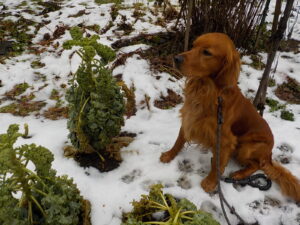
My dogs have always appeared in the column. Here is Rowan who appeared in with kale his first December
On November 8, 1998 my first gardening column appeared in my hometown paper, The Valley News of West Lebanon, NH. Since then I have written over 1,200 weekly columns and answered countless questions from readers. I am 77 years old, and plan to slow down a bit – I’ll be writing just one column per month this winter, and perhaps 2 a month after that. We’ll see.
I’ve learned a lot during that time, interviewed plenty of interesting gardeners, and visited (and written about) great gardens in New England and further afield. Thank you, dear readers for sending me suggestions, asking questions, and generally keeping me on my toes. Early on I wrote about digging in the dirt, and got an irate e-mail from a reader: “It’s not dirt,” she wrote. “It’ soil. It’s what makes a garden work well. Dirt is what you sweep up.” Later, during an election campaign, another reader told me to shut up about politics and write about what I know, gardening. As I said, you have kept me in line all these years.
My favorite interview was with Ray Magliozzi of Public Radio’s Car Talk. He lives in a suburb of Boston and has a simple but elegant garden of rhododendrons, roses, dahlias and a tropical called Datura or Angel’s Trumpet. He has the same quirky sense of humor and boisterous laugh in the garden that he had on the radio. I asked him if there was a common thread between gardening and working on cars. Quickly he answered with a full belly laugh: “Dirt. But garden dirt washes off more easily. The reason I love gardening is that I love getting my hands dirty. When we fix cars, it’s not all science. There’s an art to it, too.
Who else? The White House Gardener, Dale Haney. Tasha Tudor, the reclusive artist and gardener living in southern Vermont. Jean and Weston Cate, octogenarians who introduced me to the Seed Savers Exchange and the Boston Marrow Squash, a winter squash that they told me was the most popular squash grown in America in the 1850’s – and still grown by them. And I interviewed and became friends with Sydney Eddison, a fabulous garden writer who, when I called her recently had just come in from re-building a stone wall – even though she is now in her 90’s.. Gardeners do seem to last a long time.
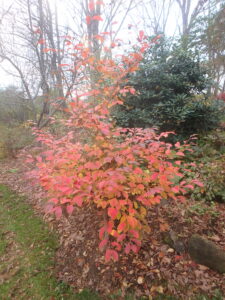
I bought this Stewartia for its blossoms and only learned later that its fall foliage is worth writing about
I love the letters and e-mails of you readers and wish I had saved them all. Here’s part of one that I got recently that might interest you: what to do about the dreaded Asian jumping worm? : “I sprinkled the tea seed meal (using my hand fertilizer spreader) and within a week (after a light rainfall which surely helped the process) the worms came to the surface (ick) and died. It would be lovely if they just stayed in the ground, but it was also gratifying to see that the tea seed meal actually worked! I have been told that they lay eggs this time of year so I will begin the process anew next spring.” She told me that she bought it at her local feed-and-grain store. My reader used 50 pounds for her lawn and gardens – about half an acre. The worms die in winter, and hatch in early summer, so I may try it as soon as I see them next summer. That said, I must warn you that even though this is a natural, organic product, it can have negative effects on fish and amphibians. Do your research, and I will, too. To be continued …
What else have I learned as part of my experience writing a column? Although I had been a gardener since I was a toddler and learned how to grow veggies and flowers from my Grampy, I took took classes to fill in the gaps in my knowledge. I went to Vermont Technical College in Randolph, Vermont and took classes including a great one about all the trees and shrubs that do well in our climatic zone. I already knew all the native trees that grow in Connecticut (where I grew up), but few shrubs and virtually no unusual decorative trees.
I took the Master Gardener course in New Hampshire, and that taught me lots of technical details about things like lawn care, insects and diseases, and lots more that I had never focused on. I drove 60 miles each way for 10 weeks to Concord, NH where I spent half a day taking classes. And I committed to helping teach others in my community – which I have been doing ever since. And it helped expand my knowledge for the column. I continue to take seminars given by experts whenever I can.
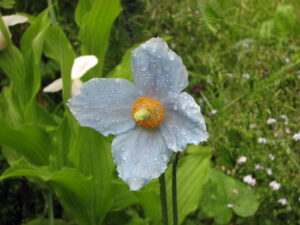
Himalayan Blue poppy is a rare color in the garden. that of the sky.
Writing a column also gave me a great excuse to buy plants. I needed to know, for example, if Toadlily or Himalayan blue poppy would do well here, and what they needed to succeed. I learned to buy perennials in groups of 3 or 5 – to make a bold statement, or to try in various locations.
I needed to learn how to design a beautiful landscape with flowers, trees and shrubs. All that was part of my education. I now grow about 200 kinds of flowers, and nearly 100 kinds of trees and shrubs. I’ve written about the ones that thrived – and the ones I’ve killed.
Eventually I learned not to buy plants unless I already have a place in mind where I might plant them. Okay, I fib a little there. I am a sucker for beautiful flowers in bloom, and will buy them – and make a place for them somewhere!
What is my advice to you after all these years? Never get discouraged or give up. But also don’t bite off too much work. Start small and increase your gardens, one bed at a time. Stay true to using organic practices: chemicals disrupt the natural balance of nature. Make a long term plan for your garden if you can. Establish sight lines, pathways, and create small “rooms” in the garden. Plant trees early on – they take the longest to reach maturity. And when you reach my age, those trees can be magnificent. I planted several in 1972 that please me every I think about them. Lastly, take time to sit down and enjoy your garden. You deserve to do so every day of the year.
I’d love tor hear from you, dear reader. Is there an
article that you remember best, or one you clipped and still refer to? I’m at
henry.homeyer@comcast.net or PO Box 364, Cornish Flat, NH 03746. Thanks!
Favorite Trees for Winter
Posted on Tuesday, February 2, 2021 · Leave a Comment
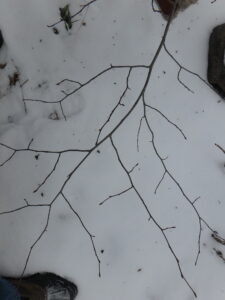
Hophornbeam branches are delicate and graceful in winter
I recently asked a few readers, garden friends and tree experts a question: “What is your favorite tree in winter?” It’s not easy to pick just one, any more than most of us would be willing to name a favorite child. I invite you to think about the question, and perhaps, come spring, you will want to plant one if you haven’t already.
Pamela Kirkpatrick of Swansea, Massachusetts sent me this: I love the winter landscape, and, next to my family, trees are my greatest love. American holly, which comes into its own in winter, both for its gleanings and the way it reflects light. Beech of any kind, for showing off its muscular trunk when not in leaf. White pine, troublesome as it is with its brittle limbs, because it is home to an owl who returns there every winter and serenades us with his call.
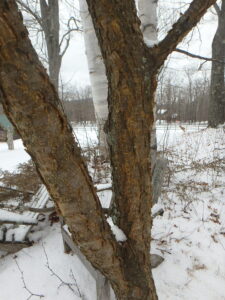
Amur maackia bark is interesting especially in winter
Lynn Schadd of Cornish, NH e-mailed me saying, “Amur maackia is for me the best four season-interest tree in the garden. And right now its magnificent bark is stealing the show peeling, curling, showing off plates of designer colors all of which may be easily seen since the tree has no oak like aspirations of bigness.
Lisa Lovelette of Waterbury Center, VT wrote, “My favorite winter tree is the pine tree when dressed in white. I am a hobbyist photographer and nothing is more beautiful than a stately pine dressed in white when placed in front of a beautiful Vermont sunset, sunrise, or majestic sky…and a rising bright and bold full moon in the background makes the dressed pine a standout.
Anne Raver of Providence, RI is a former NY Times garden writer. Here’s what she said: “My favorite tree is the scarlet oak, or the white oak, or the red oak, any kind of oak. They support hundreds of species of insects, whose caterpillars feed on the leaves, and who provide crucial food for birds. Also, the red and scarlet oaks turn beautiful colors.”
Donnamarie Kelly of Salem, NH wrote, “By far my favorite winter tree is the hemlock. When snow-laden, the boughs remind me of ballerina hands dipping delicately downward. Hemlocks are full, projecting a sense of being in the “woods” even when in a simple grove of two or three trees. “
Julie Moir Messervy, is a world-renowned garden designer and author of many great garden books. She e-mailed, “Our land in Vermont was an old sheep farm, as were so many. My favorite tree (in winter and also all year long) is a stately White Oak ( Quercus alba) that may well date from the 1800s. For me, it’s a “Cosmic Tree” that shades and shields our deck and screen porch from the harsh western sun, while opening its boughs to the cool summer winds. It is home to squirrels, porcupine, and at least 13 types of birds in winter …”

Stewartia bark photo Christine MacManus
Christine MacManus of Narragansett, RI e-mailed, “A favorite winter tree of mine is a neighbor’s Stewartia with its wonderful bark of mottled patterns and colors. I’ve kept my eye on this tree for 40 years and sometimes pull mulch away from the trunk flare. And of course the summer flowers are a bonus too.
My favorite tree authority, Mike Dirr, author of “Manual of Woody Landscape Plants” could not limit himself to just one or two. He e-mailed, saying, “I love Nyssa sylvatica (black tupelo), Fagus grandifolia (American beech), Quercus alba (white oak) , Liriodendron tulipifera (Tulip tree) and Quercus bicolor (Swamp white oak) for starters.”
I know Professor Dirr is particularly fond of “Majestic trees” – trees that tower over the landscape and last for a hundred years or more, and all of those he mentioned can do so.
JD Lavallee of Henniker, NH loves blues spruces: “In the winter, I just loved how the snow is caught in their branches forming beautiful white pillows. And light snows simply add a beautiful dusting of their needles.”
Tom Bacon of Hanover, NH emailed, “I love the majesty of the hemlocks in general, but the way they hold the snow is beautiful in the winter and just stunning compared to other evergreens.”
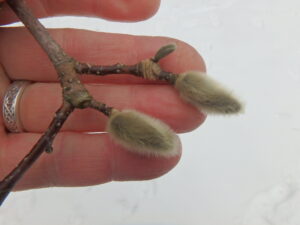
Flower buds on my Merrill magnolia are like pussywillows all winter
As for me? My favorite is the hybrid Merrill magnolia I planted long ago as a specimen tree in the back of the house. I love its smooth gray bark and the fuzzy buds like pussywillows on steroids. Those buds remind me that spring is coming, no matter how cold the weather now. Of the native trees, I love the hop hornbeam (Ostrya virginiana) in winter. The bare branches are fine and delicate, with tiny buds. The lateral branching patterns are so ornate and beautiful that I hung one on the ceiling above my computer.
One last perspective came from my friend Alicia Jenks of Weathersfield, VT. She noted that American beech trees produce a lovely rustling sound on breezy winter days. The young trees hold their leaves until May, and provide a quiet symphony in winter. And pines make such a soothing song on breezy days, too. So go outside to look – and listen – to the trees. Pay attention, and your trees may surprise and delight you.









